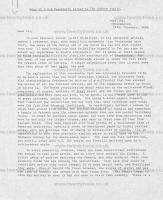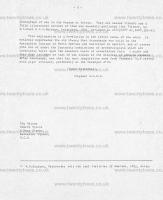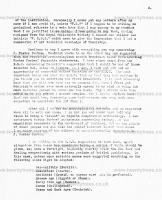Text this colour links to Pages. Text this colour links to Family Trees. Text this colour are links that are disabled for Guests.
Place the mouse over images to see a larger image. Click on paintings to see the painter's Biography Page. Mouse over links for a preview. Move the mouse off the painting or link to close the popup.
All About History Books
The Chronicle of Abbot Ralph of Coggeshall describes the reigns of Kings Henry II, Richard I, John and Henry III, providing a wealth of information about their lives and the events of the time. Ralph's work is detailed, comprehensive and objective. We have augmented Ralph's text with extracts from other contemporary chroniclers to enrich the reader's experience. Available at Amazon in eBook and Paperback.
Keiller Collection Letters is in Keiller Collection.
Nursling, Southampton,
14th February, 1939.
Dear Sir,
In your February number (p.10) Mr. Keiller (age 49), in his admirable article, quotes a statement that, when megalithic monuments like Stonehenge were built, the level of the Baltic and of the North Sea was 400 feet higher than now! (I need hardly say that Mr. Keiller himself is far too sane to attach any importance to such a statement). But it seems at first glance to raise certain difficulties about the construction of Stonehenge. the level of the ground on which Stonehenge stands is about 340 feet above the present level of the sea. A simple calculation shows that it must have then been about 60 feet below the sea!
The explanation of this remarkable fact was mystically revealed to me by no less a person than the chief architect himself, the patriarch Noah. With characteristic frankness he told me of a difficulty that has escaped the notice of all the Biblical critics, and of the ingenious method by which he solved it. The heavy precipitation which resulted in the well-known Flood, consisted, of course, entirely of fresh water; and the fishes who for generations had been born and bred, so to speak, in salt water came to him in great distress, asking his advice. Not being a water expert himself, Noah consulted the Authorities and was told that only strenuous work could save the fish from becoming fossilized. He accordingly devised a scheme by which they should swim across the drowned continent of Eurasia and construct a temple to Jehovah upon the submerged uplands that are now called Salisbury Plain. In order to increase their labour and save them from extinction they were to use only the largest stones, and were to fetch some of them from distant Wales. They were supplied with blue prints by a well-known firm of Sumerian architects, specially drawn on waterproof paper by highly skilled crabs, with ink provided free of charge by cuttle-fish or squids. (It is interesting to note that precisely similar paper is still used by the Ordnance Survey for its small-scale maps). The task was duly carried out, and shortly after 4000 B. C. the temple was formally declared open by a bottle-nosed whale.
In every community, however, there are some recalcitrant individuals who refuse to take good advice, and so there were amongst the fishes. A little group of passive resisters was formed, and they occupied their time swimming round the ark cursing the Authorities. They said they would be fossilized before they would consent to do such menial work, and fossilized they were. When at length the Flood receded, the slopes of Ararat and all the land of Armenia was strewn with huge stone fish. They remain there to this day and may be seen by any who care to visit that country. There is a photograph of one in the Museum at Erivan. They are called VISHAPS and a fully illustrated account of them was recently published (Les Vishaps, by N. Y. Marr & J. I. Smirnov, Leningrad, 1931, reviewed in ANTIQUITY XI, 1937, 122-3).
This explanation is a Revelation in the strict sense of the word. It entirely supersedes the old theory that Stonehenge was built by the Apalachian Indians of North America and dedicated to Apollo1; and of course puts out of court the fantastic conclusions of archaeologists which are invariably built upon the insecure basis of ascertained fact. I might add that Noah informed me that he was always at the disposal of genuine seekers after knowledge, and that his best inspiration came from Chambery No. 5 served with pigs' trotters, preferably at the Escargot d'Or.
Yours faithfully,
(signed) OGSC (age 52)
The Editor Modern Mystic 6 Bear Street, Leicester Square, W.C.2
Note 1. W. S. Blacket, Researches into the Lost Histories. of America, 1883, p. 193.


![]() Become a Member via our Buy Me a Coffee page to read complete text.
Become a Member via our Buy Me a Coffee page to read complete text.
24th October, 1937. Alexander Keiller (age 47) to Vere Gordon Childe.
Dear Childe,
Very many thanks indeed for your letter of the 10th which I would have answered before but, when it arrived, I was up with Influenza. I got up sooner than I should in order to return to the site of excavations in the north—weetern sector which are still in procreee and, not unnaturally, caugnt another chill and retired to bed again.
I do hope that we meet soon for I fear that your experiences as the guest of the Gazi will have laid a mantle of amnesia over your transatlantic [?].
Raymond Firth must have misunderstood my letter completely if, as you say, he though that I was irritated with R.A.I. becauoe J. Foster called himself a "Fellow" thereof. Why I wrote to Firth on the matter at all was that Foster Forbes consistently advertised the fact that he was "F.R.A.I., F.S.A." that it would be an excellent thing both these organisations forwarded a protest to the B.B.C., lest that consumately complacent body considered that these two learned Societies concurred with J.F.F.s fantastic statements, and that their silence might be taken to weigh the scales against the more articulate objctions of The Prehistoric Society, The Wilts Archaeological Society, The Hampshire Field Club and others. The Prehistorlc Society are discussing the matter on Wednesdat and will certainly send a strongly worded protest. Equally naturally, the Society of Antiquaries of London propose to do nothing about the matter at save that. "the President wili probably speak to Reith about it if he a chance when he next sees him". The Society of London have for so many yeare adopted the methods towards prehistory of the Duke of Plaza Toro that one would hardly expect them to do anything else than, actually nothing at all.
Reverting again to Firth and the R.A.I. believe no one realises better than I that such initials after one'e nane mean nothing beyond the fact that one hae been interested enouch to pay a couple of guineas or so annually for the right to use the library of the Institution. Personally I never put any letters after my name if I can avoid it, unless F.G.S. if I happen to be writing on geological subjects iun a vain hope that I may convey to my readers I that I am justified in doing so. I was going to say that, having resigned from The Royal Philatelic Society I cannot now utilise the initials "F.R.P.S." which used to give the impression that I had a commercial if not technical knowledge of Chemistry.
Needless to say I agree with everything you say concerning J. Foster Forbes. Kendrick wrote to me the other day and suggested that two reputable arehaeologists should broadcast talks contraverting Foster Forbe's fantastic statements. I have since heard from the B.B.C. concerning Kendrick's suggestion that I should be one of those selected but, owing to illness, as I say, I have not yet had an opportunity of answering either Kendrick of the B.B.C. The most important this was that the B.B.C. told me they had writted to you to ask you to undertake the frist broadcast. I do most sincerely hope that you will see your way to consent for, when I first got Kendrick's letter your name naturally sprang to my mind as being the most suitable person to undertake the task. Why I should have asked to be the second I cannot imagine, for i could, as I am sure that you could too, instantly name half-a-dozen men very much more competent to undertake the job than I.
After all I but an archaeological surveyor and excavator when all is said and done. I do not lay and never have laid claim to being a "savant" as regards comparative archaeology. I can contravert Foster Forbes' statements concerning Avebury, or the megalithic monuments in the north—east of Scotland, but so can plenty of other people who can hold the publie interest better than could I on wider aspects of the subjecty so unsatisfactorily traversed by J. Foster Forbes.
I am writing to the B.B.C. to suggesting to them that, apart altogether frocu these two immediate talks, a series of talks should be given, say once a fortnight, beginning shortly after the New Yeur and dealing respectively with various periods of British prehistory. In this case, unless more suitable names ware suggested something on the following lines might be adopted:
Palaeolithic (Burkitt).
Mesolithic (Clarke).
Neolithic (Myself, or anyone else who is preferred).
Bronze Age (Piggott or Stone).
Early Iron Age (Hawkes).
Roman (Collingwood).
Saxon and Dark Agee (Kendrick) .
With a summary of the whole to round up the course by O.G.S. Crawford. Alternatively, instead of dividing prehistory into the above hidebound compartments, certain of the talks might represent the transitionary period of one into the next,
Mesolithic — Neolithic (Clarke)
Neolithic — Early Bronze Ace ( Pit.•gott).
Bronze Age — Early Iron Ace (Hawkes).
and so on. Whnt do you think of the Idea?
Anyhow I do hope that you consent to the B.B.C's invitation, and that when you do you will give J. Foster Forbes the sheer undiluted hell that he so richly deserves and for which with sucg unparallel verbosity he has demonstrably asked.
Best wishes to you from all of us here,
Yours sincerely
John Foster Forbes: In July 1958 he died in the Brighton General Hospital after complications following an operation for peritonitis.



![]() Become a Member via our Buy Me a Coffee page to read complete text.
Become a Member via our Buy Me a Coffee page to read complete text.